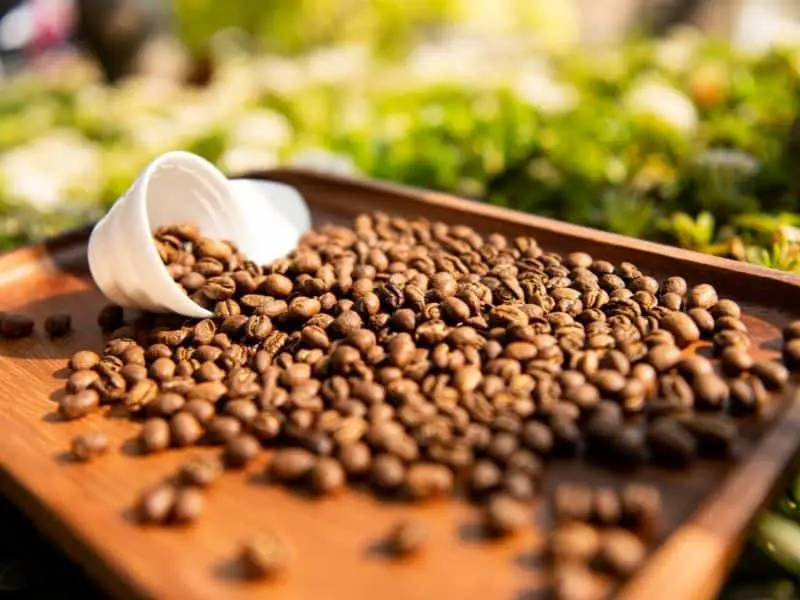If you’re a coffee-lover, then you’ve probably heard of Tanzania Peaberry coffee.
But what is it, and why is it so special? Let’s take a closer look.
What are Peaberry coffee beans?
Coffee beans are grown in two varieties, Arabica and Robusta, and when the coffee cherry has ripened, two seeds or beans are formed inside, with flat faces together.
However, in approximately 5% to 10% of every harvest, there is a mutation, a bean called the Peaberry.
A Peaberry is the result of a natural defect in which only one bean grows inside the cherry. It is larger than the normal bean since it has more room to grow; it has a rounded shape rather than the regular oval shape and does not have the same flat face as the “twin beans”, although the peaberry is generally smaller in size, like a pea.
The Peaberry bean is considered to be superior to regular beans, and peaberries from Tanzania, a country in East Africa, are especially valued, so read on to find out why coffee experts praise this bean so highly.

What is Tanzania Peaberry coffee?
Coffee plants have been grown in Tanzania for hundreds of years, but it was only under British rule in the early 20th century that the cultivation of coffee became widespread, and exported as a major crop. Today coffee is the country’s number one industry, and every year tens of thousands of metric tonnes are grown and exported.
Tanzanian coffee plantations are mostly on the slopes of Mount Kilimanjaro, and only Arabica is cultivated. At least 10% of the crop is peaberries, and these are picked out from regular beans by hand or using a sieve. Many other coffee growers around the world leave the peaberries in with the other beans. If you buy a bag of coffee beans from say, Brazil, and sort through them, you will probably find about one in ten are peaberries.
The process of hand and sieve sorting is slow and adds more cost to the production, which is why most growers do not bother with it, and why pure peaberry coffee is more expensive than regular coffee.
Tanzania has become well-known for the production of peaberry beans, and in fact, the name peaberry is synonymous with coffee from the region.
What is so special about peaberry coffee?
It can be said that taste is probably the most subjective of our senses. We all see the same objects, we hear the same sounds, but often our taste perception can be quite different from others.
That is why there are so many different opinions about the peaberry. One viewpoint is that because it is the only bean in the cherry, it gains all the available nutrients and so has a stronger, more pronounced flavor.
A contrasting viewpoint is that because the peaberry bean is a result of a defect, it lacks the qualities of a regular bean, and has less flavor.
A case can be made for either argument, but we all have to agree that peaberry coffee is very highly prized by coffee lovers around the world, and they can’t all be wrong.
How are peaberry beans roasted?
Peaberry beans are usually smaller, rounder and denser than regular beans, and so require differences in the way they are roasted.
Smaller beans roast more quickly, so a coffee producer who does not sort out the peaberry beans will always have some in the batch that is over-roasted, especially in a dark roast.
However, peaberry beans tend to be a more consistent size and so a batch of only peaberry will roast more evenly.
Because the peaberry is denser, it does not suit a light roast because the bean’s oils and acids will not be fully developed, and the coffee will have a weaker, straw-like taste.
It is better suited to a medium or dark roast, although time and temperature are crucial, and vary from the regular roasting process.
Does peaberry coffee have more caffeine?
Most coffee beans have a caffeine content of between 1.3% and 1.4%. Peaberry beans have a slightly higher caffeine content at an average of 1.42%.
In the real world, the amount of caffeine in your cup of coffee depends more on how the bean is processed and roasted.
A scoop of ground peaberry would deliver pretty much the same caffeine hit as a scoop of regular roast. It is unlikely that your body will pick up the 0.02% difference.
Does peaberry coffee taste better?
Coffee connoisseurs can certainly notice the different flavors between peaberry and regular beans. The peaberry is said to have a sweeter, rounder, slightly more acidic flavor, giving a brightness on the palate and a full-bodied mouthfeel.
Tanzanian Peaberry is known for its bright acidity, with chocolate and fruit notes. It is claimed to have a stronger taste than traditional coffee, yet less bitter.
Taste as I said above, is subjective and like a fine wine, a good peaberry will have more flavor than many other regular coffees.
But better overall? This can only be decided based on each individuals’ perception.
And the only way to find this out is to buy a bag of peaberry coffee and try it.
Final thoughts on Tanzania Peaberry Coffee
Tanzania Peaberry Coffee is a rare coffee bean that grows in Tanzania.
What makes it so special is that the coffee cherry contains only one bean (pea) instead of two. This makes up approx. 5-10% of all coffee production, making it a highly sought-after commodity.
If you’re looking for an interesting and unique cup of coffee, be sure to try Tanzania Peaberry Coffee.

